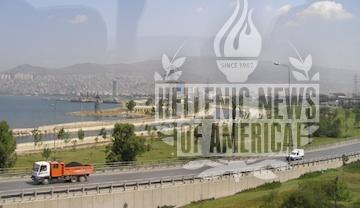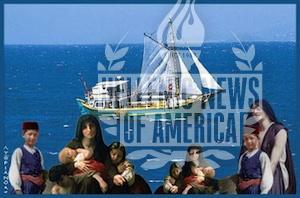Viewpoint: Descendants of Asia Minor Catastrophe Look Back
By Catherine Tsounis
September 23, 2012 commemorates the ninetieth anniversary of the “Burning of Smyrna”. Churches and Greek organizations in the United States and Abroad held a moment of silence to remember the dead martyrs. Why should we remember almost a century later the burning of a city on the shores of Asia? Christos Papoutsy in his landmark book “Ships of Mercy” says “The Greeks of Turkey were different from the Greeks of Greece. These Greeks were direct descendants of the Ionian Greeks, who settled the Aegean coast of Asia Minor, more than a thousand years ago. They were a strong, dynamic part of the population, largely controlling the banking, shipping and general mercantile business……to become penniless refugees, living in tents and driven to accept the most menial work, was a huge emotional shock……so many overcame these circumstances is a testament to the Greek spirit. Not only were people horribly wronged, but an entire region was changed as well.”
Ninety years and several generations later, their legacy is remembered in the rebetika (Greek Blues) and family recollections. Yvonne Montesantos, educator/journalist, recalls that “Families with sons who were 15 in 1922 included my grandfather, Dimitrios Markotsis (born on September 14, 1907). His father, Capt. Giorgios Markotsis owned a commercial caiyak and therefore fled with his son Dimitrios and his other children (2 girls- ages 18 and 20) – along with their mother, Adamantia Aftias Markotsis. They fled to Chios- only 12 kilometers away but really- another world- at times, a not so welcoming world. Why? Because the Markotsis family a dignified family like the rest of the Kato Panagia’s clans were PROSFEIGES (refugees) in the minds of the villagers of Chios.”
Her mother, Amalia (Emily) Markotsis Antokas said “we were the educated, merchant class that lived on the coast, not the inland farmers….. Our women were involved in weaving carpets and tapestries that were sold in Europe. The Tsemelites believed in helping people. My grandfather, Captain George Markotsis was a captain in a network of captains all related by blood. They transported products from Kato Panagia to Tseme. They didn’t live in Tseme. No one lived in Tseme City. They went there for schools, colleges, business and trade.” Their life was similar to ours in New York City of 2008. We work in New York City, but live in Astoria and Bayside in the borough of Queens.” Rev. Dimitrios J. Antokas, her son, is the presbyter of St. George Church in Bethesda, Maryland.
Panayiotis Markopoulos, explained that “everyone lived around the Chios City Fortress (Frourio) or Sinikismos. They were given houses during refugee influx of 1914. Our relatives did not want to be farmers. They wanted to go back to their ancestral homes in Kato Panagia. They stayed in the Fortress and watched their lands across the way in Turkey. There were great fishing spots in Turkeyand not in Chios. My uncles were tough captains who sailed in all weather, never afraid of storms. Kato Panagia was to Tseme what Bayside is to New York City. Our family and the Gagas family had winter homes in Kato Panagia. They all had second, summer homes in Erythrae.”
The Chian/Mikrasiatic Society of the 1950’s sponsored the publishing of a book on the life of Hatzibeis, a high ranking officer under the leadership of General Nikolaos Plastiras. He was from Tseme. In a recent Facebook message, Gus Sotirakis wrote “the man who was my grandfather’s cousin was Stamatis Hatzibeis. He was Minister of the Economy back in 1944. I know one of my uncles in Greece either showed my brother or gave him the book…Most of my family from Chios now live in Athens.” One remembers one’s roots.
Panagiota and Tasos Yerolemou, immigrants from Larnaca, Cyprus, described an encounter with a unique Turkish businessman in their New York City shop. “Six years ago, a wealthy Turk was involved in business in my store,” they said. “He was from one of the top seven families of Turkey. He said ‘the major mistake of his government was to eliminate the mercantile business community of Greeks and Armenians. We destroyed our economy. TOO LATE. We cannot bury the past. We cannot bring back the Armenians and Greeks.’”
Errikos Skouloudis has created an English/Greek bilingual blog dedicated to Erythrea, Modern Day Ildiri, and the site of the sibyls (ancient Greek/prophetesses). Mr. Skoulidis’ family settled in Sitia, Crete. He has published recently three poems from the area in Greek. One is the “Refugee Girl” who had beautiful dark eyes and married having a sad end. His photos are haunting. Mr. Skoulidis says “many stories by descendants of Asia Minor refugees exist in Eastern Crete. These memories are alive and part of our life today. Thousands of tragic pages were written in the soil of Asia Minor. Each refugee narrated his/her own story. Many spoke of Turks who helped save them during the persecution.”
Visit https://erythrealithri.blogspot.com/2011/05/temple-of-virgin-at-alatsata-and.html
I presented the following viewpoint, as a descendant of Western Anatolians to a group of Vaughn College students from the heartland of Turkey. “My grandparents told us they lived in harmony with their Muslim neighbours for hundreds of years, until the Western Powers backed a Greek invasion,” I said. “Then they were abandoned. They fled, forced to leave all behind, to be mistreated in Greece. They would look with intense longing at their homes from the shores of Chios, crying for a lost Paradise. On the coast of Chios, in 2012, the descendants still look at their ancestral lands with longing for a time when Christian and Muslim lived in harmony and prosperity.” The audience was quiet, and attentive.
The 90 Year Anniversary of the “Smyrna Tragedy” can best be summarized by the words of singer Angela Papazoglou (Smyrna 1899-Kokinnia 1983): “The beauty of Smyrna was not the houses or streets. The beauty of Smyrna was us, the Greeks, the Romans, and the Smyrneoi. The beauty of the Greeks was not the locations or the marbles. It was the bravery (Leventia) they had in their souls,”
Photo 1 – Present Day Izmir Harbor, site of disaster.
Photo 2- Memories of Erythrai from Errikos Skoulidis unique blog https://erythrealithri.blogspot.com/2011/05/temple-of-virgin-at-alatsata-and.html











